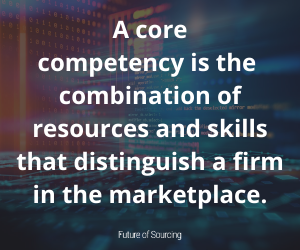The core competency concept developed by Prahalad and Hamel laid the groundwork for how the modern company should operate and how it should outsource.
In 1990, two business academics, C.K. Prahalad and Gary Hamel, teamed to write one of the Harvard Business Review's most influential articles on the nature of the modern firm and, by extension, outsourcing. They introduced the concept of core competence, which they called the “most powerful way to prevail” in global commerce.
Prahalad, who died in 2010, was the Paul and Ruth McCracken Distinguished University Professor of Corporate Strategy at the University of Michigan Stephen M. Ross School of Business. Dr. Gary P. Hamel is an American management expert, and a founder of Strategos, an international management consulting firm based in Chicago.
Learn more about Kate Vitasek and her role as a SIG University Faculty Member.
The Origin of Core Competencies
Prahalad and Hamel defined core competenciesas the collective learning in the organization, especially how to coordinate diverse production skills and integrate multiple streams of technologies. Simply put, core competency is the combination of resources and skills that distinguish a firm in the marketplace. 
Hamel and Prahalad predicted that top executives would be judged on their ability to identify, cultivate and exploit the core competencies that make growth possible. Indeed, they'll have to rethink the concept of the corporation itself.
Rethinking the concept of the corporation is exactly what happened. As globalization was taking off, the deceptively difficult but critical task facing management was "create an organization capable of
infusing products with irresistible functoriality or, better yet, creating products that customers need but have not yet even imagined." They noted that core competence encompasses communication, involvement and a deep commitment to working across organization boundaries. The mind-shift trick they recommended was the ability to think of the company as much more than a collection of discrete businesses and then to integrate sourcing strategies built on competence leadership.
Prahalad and Hamel contended that maintaining world manufacturing dominance in core products, a company would reserve the power to shape the evolution of end products. The core competence concept helped focus managers on business and market essentials, and also identified the areas that were non-core. Thus, the identification of core competencies moved in line with the growth of outsourcing. It can be argued that Prahalad and Hamel's core competency idea boosted both insourcing, by identifying critical internal functions, and outsourcing, by identifying functions suitable for outsourcing.
>>Read more on the academics of sourcing by Kate Vitasek<<
Variables of the Four Core Competencies
As part of their work, Prahalad and Hamel developed a Core Competence Model. The model focuses on a combination of specific, collaborative, integrated and applied knowledge, skills and attitude. The model, which should not focus on fighting off the competition, but on creating a new competitive space, comprises four core competencies:
- Resources: the sources for the development and acquisition of skills and technologies
- Capabilities: The possibilities to build core competencies
- Competitive advantage: the challenge to acquire and develop the largest possible market share of core products
- Strategy: the strategy to develop the largest possible market share of finished products
Identifying the core competency permits an organization to safely and wisely outsource non-core activities. It also creates conditions for collaboration both within the organization and outside of it. In other words, “Do what you do best, and outsource the rest!”
"The goal is to build a strong feeling of community and to a great extent their loyalty should be to the integrity of the core competence area they represent and not just to particular businesses,” they wrote.
Check Your Work
But what happens if you have heeded Prahalad and Hamel’s advice and outsourced but outsourcing is not living up to the promise? My take is that if you outsourced because it was not a core competency, don't think about bringing the work back in house.
Instead, look in the mirror and understand how you outsourced. Perhaps you are using the wrong sourcing business model for your outsourcing deal or have created what I lovingly refer to as Doberhuahua, a dysfunctional contract laden with perverse incentives.
Prahalad and Hamel were prescient and visionary back in 1990: “Core competencies are the wellspring of new business development. They should constitute the focus for strategy at the corporate level,” they concluded.
The importance of the core competency concept developed by Prahalad and Hamel is seminal because it laid the groundwork for how the modern company should operate and how it should outsource.






